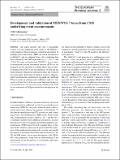Development and validation of HERWIG 7 tunes from CMS underlying-event measurements
Author(s)
Sirunyan, A. M; Tumasyan, A.; Adam, W.; Ambrogi, F.; Bergauer, T.; Dragicevic, M.; Erö, J.; Escalante Del Valle, A.; Frühwirth, R.; Jeitler, M.; Krammer, N.; Lechner, L.; Liko, D.; Madlener, T.; Mikulec, I.; Pitters, F. M; Rad, N.; Schieck, J.; Schöfbeck, R.; Spanring, M.; ... Show more Show less
Download10052_2021_Article_8949.pdf (5.474Mb)
Publisher with Creative Commons License
Publisher with Creative Commons License
Creative Commons Attribution
Terms of use
Metadata
Show full item recordAbstract
Abstract
This paper presents new sets of parameters (“tunes”) for the underlying-event model of the
$${\textsc {herwig}} \,7$$
H
E
R
W
I
G
7
event generator. These parameters control the description of multiple-parton interactions (MPI) and colour reconnection in
$${\textsc {herwig}} \,7$$
H
E
R
W
I
G
7
, and are obtained from a fit to minimum-bias data collected by the CMS experiment at
$$\sqrt{s}=0.9$$
s
=
0.9
, 7, and
$$13 \,\text {Te}\text {V} $$
13
Te
. The tunes are based on the NNPDF 3.1 next-to-next-to-leading-order parton distribution function (PDF) set for the parton shower, and either a leading-order or next-to-next-to-leading-order PDF set for the simulation of MPI and the beam remnants. Predictions utilizing the tunes are produced for event shape observables in electron-positron collisions, and for minimum-bias, inclusive jet, top quark pair, and Z and W boson events in proton-proton collisions, and are compared with data. Each of the new tunes describes the data at a reasonable level, and the tunes using a leading-order PDF for the simulation of MPI provide the best description of the data.
Date issued
2021-04-12Department
Massachusetts Institute of Technology. Department of PhysicsPublisher
Springer Berlin Heidelberg
Citation
The European Physical Journal C. 2021 Apr 12;81(4):312
Version: Final published version